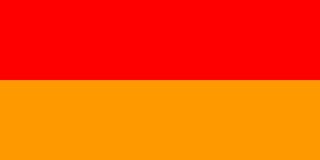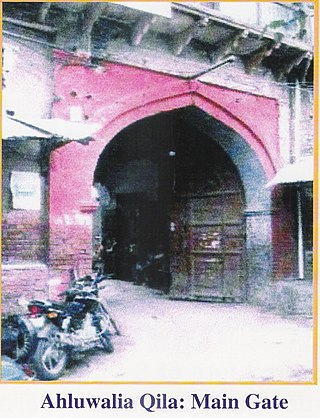Related Research Articles

The Holkars were a powerful family that was part of the Maratha Confederacy, which held the rank of subahdar under Peshwa Baji Rao I. When the Maratha Empire began to weaken due to internal clashes, the Holkars declared themselves rulers of the Indore in Central India, which existed as an independent member of the Maratha Empire until 1818. Later, their kingdom became a princely state under the protectorate of British India.

The Gilgit Agency was an agency of the British Indian Empire consisting of the subsidiary states of the princely state of Jammu and Kashmir at its northern periphery, mainly with the objective of strengthening these territories against Russian encroachment. The subsidiary states included Hunza, Nagar and other states in the present day districts of Gupis-Yasin, Ghizer, Darel, Tangir and Diamer. The agency headquarters was based in the town of Gilgit, which was itself under the direct administration of the Maharaja of Jammu and Kashmir.
The Düsseldorf School of painting is a term referring to a group of painters who taught or studied at the Düsseldorf Academy roughly between 1819 and 1918, first directed by the painter Wilhelm von Schadow.

Raja Sir Tanjore Madhava Rao, KCSI, also known as Sir Madhava Rao Thanjavurkar or simply as Madhavarao Tanjorkar, was an Indian statesman, civil servant, administrator and politician who served as the Diwan of Travancore from 1857 to 1872, Indore from 1873 to 1875 and Baroda from 1875 to 1882. He was the nephew of the former Diwan of Travancore T. Venkata Rao and the son of T. Ranga Rao who was also the former Diwan of Travancore.

Baroda State was a princely state in present-day Gujarat, ruled by the Gaekwad dynasty of the Maratha Confederacy from its formation in 1721 until its accession to the newly formed Dominion of India in 1949. With the city of Baroda (Vadodara) as its capital, during the British Raj its relations with the British were managed by the Baroda Residency. The revenue of the state in 1901 was Rs. 13,661,000. Baroda formally acceded to the Dominion of India, on 1 May 1949, prior to which an interim government was formed in the state.

Datia State was a princely state in subsidiary alliance with British India.

Jath State, was one of the non-salute Maratha princely states of Deccan States Agency, one of the former Southern Maratha Jagirs. Jath State and Daphlapur State were the only two states belonging to the Bijapur Agency under the Bombay Presidency, which later became part of the Deccan States Agency.

Bikaner State was a princely state in the Rajputana from 1465 to 1947. The founder of the state, Rao Bika, was the eldest son of Rao Jodha, ruler of Jodhpur. Rao Bika chose to build his own kingdom instead of inheriting his father's. Bika defeated the Jat clans of Jangladesh along with his uncle Rao Kandhal and his adviser Vikramji Rajpurohit and founded his own kingdom. Its capital was the city of Bikaner in the northern area of present-day Rajasthan State in India. Karni Mata has been designated as the kuldevi of the Royal family of Bikaner.

Events in the year 1837 in India.

Gaurihar State was a princely state in India, ruling a territory that is now in Madhya Pradesh. Gaurihar is a tehsil of Chhatarpur district.

Morvi State, also spelled as Morvee State or Morbi State, was a princely salute state in the historical Halar prant (district) of Kathiawar during the British Raj.

Sarangarh was a princely state in India during the British Raj ruled by a Raj Gond dynasty. The emblem of the state was a turtle.
This article details events in the year 1840 in India. Occurrences include the establishment of the Bank of Bombay, and the fall of the Maqpon dynasty.
This article details events occurring in the year 1839 in India. Major events include the reduction of the Khanate of Kalat to a subsidiary ally of the British, and the capture of Aden in Yemen by the East India Company, creating an important stopover for voyages between Europe and India.
This list details events in the year 1838 in India. Major events include the Agra famine of 1837-38, and the founding of the Times of India on 3 November.
Events in the year 1851 in India.

Ahluwalia was a misl, that is, a sovereign state in the Sikh confederacy of Punjab region in present-day India and Pakistan. The misl's name is derived from Ahlu, the ancestral village of the misl leaders. The Ahluwalia misl was one of the 12 major Sikh misls, and held land to the north of Sutlej river.
References
- ↑ Imperial Gazetteer of India: Provincial Series, Volume 12. Superintendent of Government Print. 1908. p. 397.
- ↑ India Foreign and Political Department (1892). A Collection of Treaties, Engagements, and Sunnuds, Relating to India and Neighbouring Countries: Central India Agency, pt. 1-2. G.A. Savielle and P.M. Cranenburgh, Bengal Print. Company. p. 38-39.